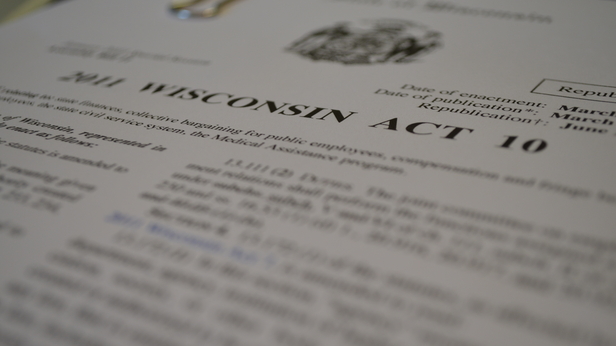
MacIver News Service | April 26, 2017
By M.D. Kittle
[Madison, Wis…] – Call it a communication gap, but 12 percent has suddenly become contentious again.Some public school officials are upset with a carrot and stick in Gov. Scott Walker’s 2017-19 budget that ties additional state aid payments to compliance with a key component of Act 10 – Walker’s 2011 law that reshaped the negotiating relationship between the taxpayer and public employees.
Act 10, among other reforms, prohibits local government employers that health insurance through the state’s Group Insurance Board to pay more than 88 percent of the “average premium cost” of plans in the program. Those general government employees are required to pay at least 12 percent of the premium cost.
The exception includes law enforcement personnel, firefighters and transit workers.
Walker’s budget calls for $649 million in increased state public education spending, but districts with health insurance plans outside of the state Group Insurance Board system would have to comply with the 12 percent premium provision in order to pick up additional per-pupil aid. Currently, the 12-percent requirement does not apply to those districts on independent plans.
The Madison Metropolitan School District has been in a lather over missing out on $16 million in state aid if it continues to absorb more employee health insurance obligations than would be allowed.
Madison’s progressive school board had long resisted making employees pick up their premium costs, instead asking taxpayers to foot the bill. Last year, teachers began paying 3 percent of their premiums.
Mike Barry, budget director for the Madison school district, told the Wisconsin State Journal that the district found ways to offset the cost of covering employees’ required share. Barry described it as “the Madison Way.”
The Madison Way calls for yet another property tax increase ($94 on an average home), at least under the recent “balanced budget” proposal presented by Madison School District Superintendent Jennifer Cheatham.
Cheatham’s plan seeks an $8.4 million increase over this school year’s $389.7 million operating budget.
While the district is contemplating following the 12 percent compliance provision, it again intends to do so in “the Madison Way.”
“The budget for next school year also could require district employees to pay 12 percent of their health insurance premiums — though the budget plan recommends doing it in a way that wouldn’t actually take any more money out of district employees’ pockets,” the State Journal reported. “Instead, the district could find cost savings and use them to raise wages and salaries.”
Republican supporters of Walker’s compliance requirement argue that the law is the law, and that it shouldn’t be difficult to follow.
But some contend that the 12 percent requirement is too rigid, particularly in a highly competitive world of teacher recruitment. More so, districts that cut costs elsewhere to make up for covering more than 88 percent of employee health insurance premiums shouldn’t be penalized, they argue.
The potential bigger problem, according to a Wisconsin Legislative Council memo obtained by MacIver News Service, is the broader compliance language in Walker’s budget. It states that any district that receives the pledged additional per-pupil state aid must require its employees to pay at least 12 percent of “all costs and payments associated” with employee health care coverage plans.
That raises questions about the intent of the bill.
“This language is similar to, but does not precisely overlap, the Act 10 requirement for local public employers who are participating in the state’s program to pay no more than 88% of the average premium cost of plans offered in the program,” states the March 1 Legislative Council memo.
The broader “all costs and payments” could be “interpreted as being more expansive than applying only to premiums and like contributions,” the memo states.
What about the variety of health plan designs operating outside of the basic premium model? What about cost sharing of deductibles, co-payments, or co-insurance? Health savings accounts? Are these areas included, the Legislative Council memo asks. If not, is there a disparity in public employee/employer payments under the compliance language?
Among other possible revisions, the council proposes the new requirement provide a “similar effect,” including only traditional premiums and like contributions and excluding high deductible plans and out-of-pocket costs.
Walker earlier this week said he hopes the Legislature keeps some of the measure in.
“If they want to tweak it slightly, that’s fine,” the governor said Monday.
Members of the powerful budget-writing committee have said they plan to keep intact the governor’s $649 million increase for K-12 schools, but he believes the funding hike should come with accountability requirements like the Act 10 compliance proposal.
School districts would have to certify that school employees are paying the required percentage of health care coverage costs, a requirement known as the “Act 10 compliance provision.”
Accountability has been a sore spot. The MacIver Institute has conservatively estimated Act 10-related savings at more than $5 billion, but that information has been extremely difficult to come by. Savings stem from employee contributions to health care premiums, state pensions, and limits on wage increases, among other public sector collective-bargaining reforms.
“I just believe that when we’re putting more in, whether it’s K-12 or technical colleges or the University of Wisconsin System, that we should have some degree of assurance that it’s going to be in performance, that it’s actually going to deliver the promises made,” Walker said. “And in this case, I think using the tools that were given to school districts under Act 10 ensures that those dollars will go into the classroom where they’re intended to show student success.”
